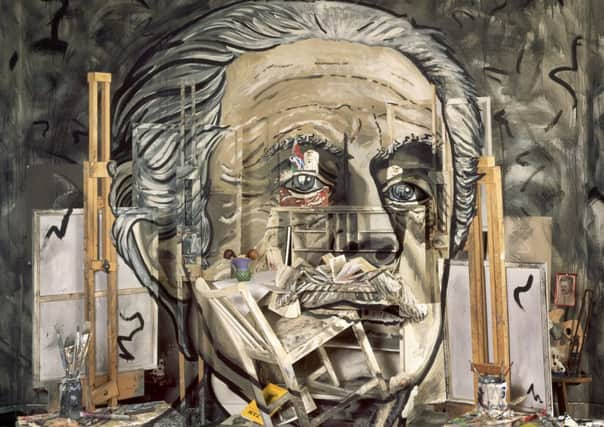Art review: The RSA Annual Exhibition 2018, Royal Scottish Academy, Edinburgh


Art review: The RSA Annual Exhibition 2018, Royal Scottish Academy, Edinburgh ****
Developing the theme, on the opposite wall is a group of Alexander Moffat’s portrait drawings of the poets MacDiarmid gathered round him or inspired. But as Colvin’s own picture of MacDiarmid makes clear, you cannot deal with the interaction of painting and poetry, a significant part of Scotland’s recent cultural history, only by painting the poets. Consequently he has also not only invited artists, but also poets to collaborate with them and others among the academicians, or to write in response to their work. There will also be readings and related events during the exhibition. Collaborating in this way, artist Derrick Guild and poet Robert Crawford, for instance, have produced several works together. WIFIWIFE, sets out those two words repeated without spaces 30 times each in a square block of ten lines. Two exquisitely painted eyes and part of a face borrowed from historic female portraits hang framed alongside. The point seems to be that if wife and wifi can really be confused, we have not exactly achieved emancipation in the home.
Advertisement
Hide AdThe photographer Robin Gillanders is an invited artist. He has contributed a set of enigmatic still-life photographs to complement a poem by Henry Gough-Coooper. In another single work, however, A Fragment of the Old Ash... he introduces a figure central to this theme. The old ash was almost the only mature tree that stood in the place that became Little Sparta when Ian Hamilton Finlay and his wife first moved there. Not long after the poet-artist’s death the ash blew down. The picture is an eloquent memorial.


A rather beautiful film of oranges bobbing in a fast running stream is a collaboration between invited artists Pernille Spence and Zoe Irvine and poet Raman Mundair, whose related poem is presented alongside. Rab Wilson has written a poem in Lallans about Seer by Annie Cattrell. This is the maquette for a public sculpture in Inverness which will evidently be composed of two jagged pieces of white marble. The sculpture is apparently a tribute to the Bran Seer though I am not sure he would have understood much Lallans.
All this and much else sits very comfortably in the frame provided by the work of the wider Academy and one or two other invited artists. This reflects on the appositeness of the choice of theme, the quality of the work itself, but also on the great skill with which the show has been hung. Standing in the galleries you get no sense of crowding. Indeed the works seem natural companions, yet there are almost 350 of them by around 150 individuals, though these figures do include the architects about whom I do not have space to write.
An elegant, life-size bronze figure by Michael Snowden stands to greet you at the stop of the stairs. Past it in the gallery to the left you can see part of a free-standing, eight-fold screen made by Frances Walker. It is a view westwards from the green pastures of Tiree out across the Atlantic with the clouds of an approaching storm veiling the sun. Ranging effortlessly from the curvature of the horizon to the tiny detail of sheep and cattle grazing, it shows a breathtaking command of atmosphere, scale and space. On the wall beyond it is Lake Tekapo by Adrian Wiszniewski, painted on six panels and on a similar scale. As well as paint, this image appears to be drawn in ink. The consequent, insistent line gives striking rhythm and drama to the picture. Together these two works show how if anyone can paint a landscape, it is something else altogether to create a sense of the pervasive energy of nature. Nearby Will Maclean achieves something similar in a pair of stormy charcoal drawings.
Visible in the right hand gallery as you enter is a work by Doug Cocker on a scale to match those of Walker and Wiszniewski. It is a huge installation of abstract and semi-abstract shapes. Mostly vertical, some look like tools, some like symbols, all are sharply defined and painted in bright red, yellow, green and blue. In addition, if you pick up a set of earphones, their polychrome dance is matched by a reactive soundtrack composed by Cluny Strachan.


A different sort of polychrome drama, Gilgamesh and the Serpent, a big painted nightmare by Ian McCulloch, dominates the west end of the principal gallery. At the other end, Arkiv, by the Academy’s president Arthur Watson, is more reflective. It is a sort of boxed retrospective including drawings of work going back over the years and including for example the dramatic yellow oilskins that starred in the Venice Biennale in 1990. Quieter too are works by Paul Furneaux, including both prints and paintings, and sculptures by Mary Bourne. Adore, a simple cup shape cut into a standing slab of white marble, is particularly beautiful.
Advertisement
Hide AdDownstairs and almost the last work in the show, a superb, life-size drawing by Jennifer MacRae, Post Performance: Vladimir, Lyceum, Godot, brings us back to art and poetry, or at least to drama. It is also paired with a fine self-portrait of the artist. Not so long ago, the Academy could with some justice have been seen as conservative. That is clearly no longer true. This show demonstrates a vigorous institution representative of a lively and forward-looking artistic community.
Finally there is always a valedictory note to the RSA’s annual show in the long established custom of including a small obituary display for recently departed academicians. This year they include Philip Reeves, Vincent Butler, George MacPherson and Barbara Balmer, all represented here by works that remind us of the great contributions that they made.
Until 6 June